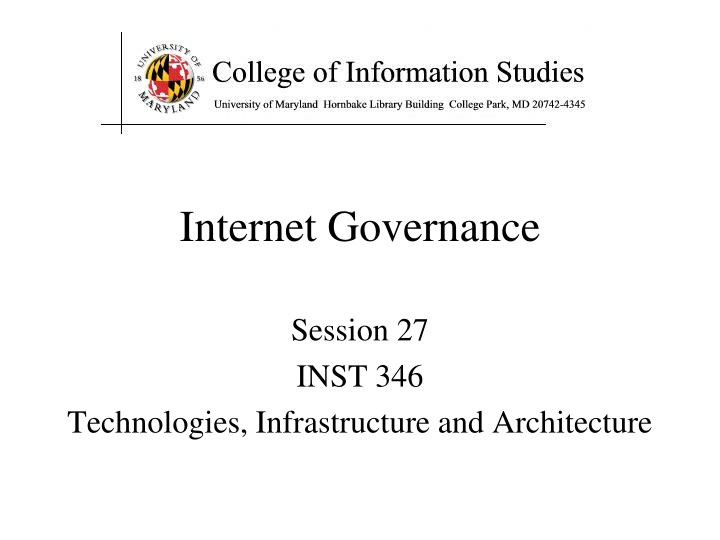
Internet Governance: Technologies, Infrastructure, and Standards
Explore the layers of internet governance, key players like ICANN and IETF, multiple jurisdictions involved, and various standards bodies shaping the digital landscape. Delve into the intricate web of physical infrastructure, logical layers, and content management that define the internet governance ecosystem.
Download Presentation

Please find below an Image/Link to download the presentation.
The content on the website is provided AS IS for your information and personal use only. It may not be sold, licensed, or shared on other websites without obtaining consent from the author. If you encounter any issues during the download, it is possible that the publisher has removed the file from their server.
You are allowed to download the files provided on this website for personal or commercial use, subject to the condition that they are used lawfully. All files are the property of their respective owners.
The content on the website is provided AS IS for your information and personal use only. It may not be sold, licensed, or shared on other websites without obtaining consent from the author.
E N D
Presentation Transcript
Internet Governance Session 27 INST 346 Technologies, Infrastructure and Architecture
Layers of Internet Governance Physical Infrastructure Logical Layer Content Layer
Agenda Jurisdiction Internet Engineering Task Force (IETF) ICANN Other Standards US-CERT
Multiple Jurisdictions Content creator Server owner Server location Router location Storage location User location User nationality International (radio, oceans, outer space)
Some IETF Requests for Comment RFC 5000 RFC 1700 RFC 1122 RFC 1123 RFC 791 RFC 792 RFC 1112 RFC 768 RFC 793 RFC 854 RFC 855 RFC 959 RFC 821 RFC 1869 RFC 1870 RFC 822 RFC 1049 RFC 1034 RFC 1035 RFC 974 Internet Official Protocol Standards, 5/2008 Assigned Numbers, J. Reynolds, 10/20/1994 Requirements for Internet Hosts - Communication layers, 10/1/1989 Requirements for Internet Hosts - Application and support, 10/1/1989 Internet Protocol, 9/1/1981 Internet Control Message Protocol, 9/1/1981 Host extensions for IP multicasting, 8/1/1989 User Datagram Protocol, 8/28/1980 Transmission Control Protocol, 9/1/1981 Telnet Protocol specification, 5/1/1983 Telnet option specifications, 5/1/1983 File Transfer Protocol, 10/1/1985 Simple Mail Transfer Protocol, 8/1/1982 SMTP Service Extensions, 11/6/1995 SMTP Service Extension for Message Size Declaration, 11/6/1995 Standard for the format of ARPA Internet text messages, 8/13/1982 Content-type header field for Internet messages, 3/1/1988 Domain names - concepts and facilities, 11/1/1987 Domain names - implementation and specification, 11/1/1987 Mail routing and the domain system, 1/1/1986
Internet Corporation for Assigned Names and Numbers (ICANN) Mission: Enable universal resolvability Assigns IPv4 and IPv6 address blocks Subassigned to Regional Internet Registries Domain name management Auctions Top-Level Domain (TLD) names Accredits domain name registrars Establishes dispute resolution framework Establishes WHOIS policy Assigns well-known port numbers
Other Standards Bodies World Wide Web Consortium (W3C) Web standards (HTTP, HTML, CSS, DOM, ) International Standards Organization (ISO) Unicode IEEE Link-layer standards for Ethernet and WiFi One-off standards JPEG, MPEG
CERT-US and CERT/CC Accept reports of vulnerabilities Mandatory for US government (to CERT-US) Voluntary for others (to CERT/CC) Generally disclosed within 45 days Coordinated national incident response NIST National Vulnerability Database
